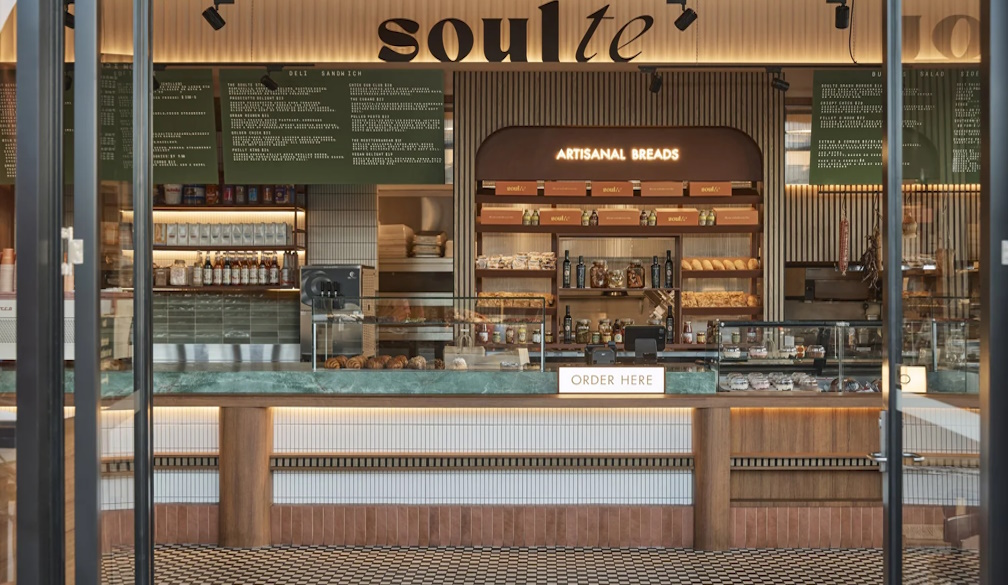Soul te: From Deli and Bakery to a Contemporary Neighbourhood Hub

Soul te recasts the familiar deli and bakery as a place to meet, linger, and return to often. The design honours tradition while pushing the format forward, so the room reads as both memory and new habit. Rather than treating brand and fitout as separate, the interior becomes the brand’s voice. Guests see, touch, and move through that voice from the first step inside to the final takeaway bag.
Material Choices That Carry Meaning
Green marble sets the tone, anchoring the counter and joinery with weight and calm. It signals quality and creates a sense of permanence. Around it, a palette of bright, sun-drenched colours calls up the warmth of an Italian summer. Terracotta tiles, soft limewash, and brushed metals add texture. Each finish feels selected, not generic, which keeps the room honest to its deli roots while still reading as current.
These choices work hard. Stone and dense timbers tolerate daily service. Warm textures soften acoustic bounce at busy periods. Light-catching surfaces make pastries, cured meats, and fresh produce look vibrant without theatrical tricks. The outcome is a space that looks good in the morning and still feels welcoming when the last espresso is poured.
Layout That Serves Both Speed and Stay
A deli must manage queues, quick orders, and dine-in. Soul te’s plan sets clear zones: an efficient takeaway lane, a considered display with easy sightlines, and pockets for longer visits. Banquettes along the wall support groups, while small tables near the window suit solo guests and pairs. Circulation is obvious, so no one hesitates about where to stand or where to collect.
Experienced restaurant interior designers often speak about the choreography between staff and guests. Here, that thinking shows in the way the counter meets the floor, the spacing between stools, and the gentle turn from display to pay point. Nothing feels forced, yet the room quietly instructs people how to move.
The Colour and Light Story
Colour does more than decorate. It guides mood and appetite. Soul te leans into citrus notes and sun-washed tones that bring energy without glare. Lighting stays layered and modest. Warmer lamps over tables invite dwell time, while brighter task lights focus on the cabinet and bread wall. The shift in intensity nudges behaviour, so peak service feels brisk and afternoons feel relaxed.
These moves also support photography. In a social era, guests often record their visit. Natural-leaning light and honest colours keep images true to life, which helps word of mouth and digital reach without heavy marketing tactics.
Detailing That Invites Touch
Handles, cut-outs, and edge treatments matter. A brass pull with a soft radius, a timber lip that keeps elbows at ease, a stone return that catches crumbs before they hit the floor, all these details reduce friction in daily use. Materials age with grace, which is essential in a place that trades seven days. The patina that develops becomes part of the story rather than a maintenance problem.
Back-of-house holds equal weight. Storage, dish runs, and staff circulation sit tight to the counter so service stays nimble. Here, the discipline often seen from office interior designers proves useful, since efficient work zones keep the front clean and calm.
Hospitality with Neighbourhood Intent
Soul te treats hospitality as a civic act. The design supports short visits on weekdays and longer, chatty Saturdays. A perch near the entrance lets locals wave to friends, a quieter corner at the rear suits prams or a laptop session. The room reads inclusive without a sign saying so. Many venues lean on hospitality interior designers to achieve this balance of polish and ease, and the approach lands well here.
The pastry and deli displays borrow the easy, familiar cues you expect from cafe interior designers, but they stay clean and uncluttered. There’s breathing room between each item, so your eye lands on the good stuff and the heroes sell themselves. People can point, order, and move on without jostling, which is handy when the queue reaches the door.
Heritage as Experience, Not Replica
Nostalgia shows up in the bones of the place, not in props. A bread wall nods to old-school bakeries, a cool marble slab hints at a traditional salumeria, and the letterforms carry a gentle mid-century note. It honours memory without dressing the room in costume, leaving space for the brand to speak in its own voice.
Collaboration and Lessons for Future Projects
Turning a deli into a lively community spot is a team sport. Operations, brand and build need to sit at the same table from day one, so the plan, palette and detailing pull in the same direction. Lead times are real, so suppliers shape what’s practical and when it lands. Studios known for clear retail logic and warm hospitality touch tend to thrive here. The teams locals call the best interior designers Sydney balance heritage with fresh thinking, which helps places like Soul te stay relevant long after opening week.
For owners and developers, working with commercial interior designers Sydney sets plain expectations around compliance, durability and budget staging. Lock in the big calls early, stone thickness, tile module, lighting control, and you avoid costly rework. A tight brief on menu, service speed and daily peaks lets the layout breathe when the rush hits, so the venue feels effortless from the first coffee to the last loaf.
Why the Model Works
Soul te succeeds because the design gives equal care to memory and modern habits. People come for a panino or a loaf, then stay because the room encourages it. Green marble grounds the experience. Bright colours lift the mood. Tactile details feel good to use. The plan respects the rush and the lull. In combination, these choices build loyalty.
Any neighbourhood venue can treat its interior as a quiet promise, made visible through material, colour, and considered movement. When a project holds that line, the result is not only a place to buy bread, it becomes a weekly anchor for the street. That is the power of a deli and bakery reframed for now, guided by a team who think like makers, traders, and hosts at once.

